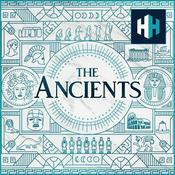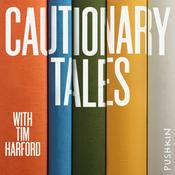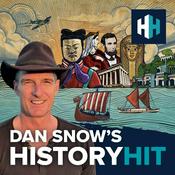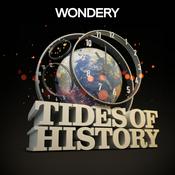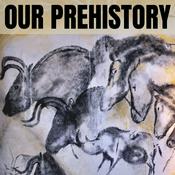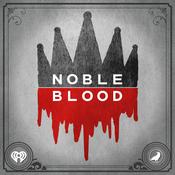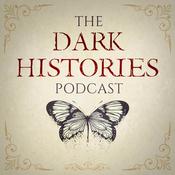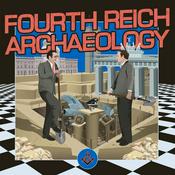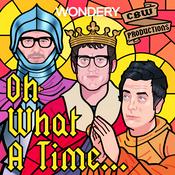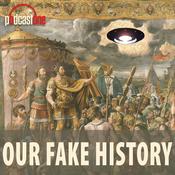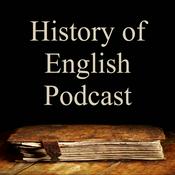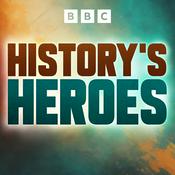182 episodes
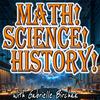
REPOST: The Wake of HMS Challenger
06/1/2026 | 37 mins.
In this repost episode of Math! Science! History!, Gabrielle Birchak speaks with Professor Gillen D'Arcy Wood, author of The Wake of the HMS Challenger: How a Legendary Victorian Voyage Tells the Story of Our Ocean's Decline. Together, they uncover how a nineteenth-century Royal Navy warship transformed into a floating laboratory and gave humanity its first global snapshot of the oceans. From discovering thousands of new species to inspiring NASA's Challenger shuttle, the expedition shaped modern oceanography and continues to inform today's conservation science. Wood's biocentric storytelling reminds us that to save our planet, we must first fall in love with it again, to be, as he says, re-enchanted by the living ocean that sustains us all. Three Things Listeners Will Learn How the HMS Challenger (1872–1876) became the first global oceanographic expedition, collecting temperature, depth, and biological data still used today. Why Gillen D'Arcy Wood's "biocentric" approach reframes history through the perspective of marine life rather than human explorers. What the voyage teaches us about modern ocean crises: from overfishing and warming seas to microplastics—and how species like the green turtle show that recovery is possible. Resources and Further Reading The Wake of the HMS Challenger by Gillen D'Arcy Wood - HarperCollins Publishers Explore more on our website: mathsciencehistory.com To buy my book Hypatia: The Sum of Her Life on Amazon, visit https://a.co/d/g3OuP9h Let's Connect!Bluesky: https://bsky.app/profile/mathsciencehistory.bsky.social Instagram: https://www.instagram.com/math.science.history Facebook: https://www.facebook.com/mathsciencehistory LinkedIn: https://www.linkedin.com/company/math-science-history/ Threads: https://www.threads.com/@math.science.history Mastodon: https://[email protected] YouTube: Math! Science! History! - YouTube Pinterest: https://www.pinterest.com/mathsciencehistory 🎧 Enjoying the Podcast? ☕ Support the Show: Coffee!! PayPal Leave a review! It helps more people discover the show! Share this episode with friends & fellow history buffs! Subscribe on your favorite podcast platform Check out our merch: https://www.mathsciencehistory.com/the-store Music: All music is public domain and has no Copyright and no rights reserved. Selections from The Little Prince by Lloyd Rodgers Smooth Piano by Universefield Musinova - Travelling And Discovering (Marimba World Percussion) Documentary-Nikita Kondrashev Audio Editor: Podcast mixed by David Aviles Until next time, carpe diem!

REPOST! The 2220 Holiday Puzzle!
30/12/2025 | 14 mins.
Set in the year 2220, this holiday puzzle episode blends science fiction, real scientific legacies, and mathematical reasoning into an immersive problem-solving adventure. The United Nations Time-Travel Division recruits four brilliant scientists, each descended from historically significant scientific families, and sends them back to 2019 with a radical mission: erase the year 2020 from the timeline. What follows is a multi-step logic and distance puzzle involving self-driving hover cars, state capitals, precise velocity calculations, and a final anagram that reveals what humanity might have gained if an entire year of global disruption never happened. This episode invites listeners to actively engage with math, geography, and history, using real tools like Google Maps to solve a futuristic mystery. What You'll Learn in This Episode 1. How Scientific Lineage Shapes Discovery Across Centuries - Meet four fictional descendants of real Nobel-winning scientists, including the Curie family, the Mosers, Isabella and Jerome Karle, and Jane and Alexander Marcet. This episode highlights how scientific knowledge, curiosity, and impact can echo across generations, shaping both history and imagined futures. 2. How Distance, Speed, and Direction Combine in Real-World Math - Using detailed velocity changes, directional turns, and travel times, listeners calculate the total linear distance each hover car travels to reach Niagara Falls. The puzzle reinforces applied math concepts, including unit conversion, cumulative distance, and approximation, all grounded in real geographic constraints. 3. How Geography and Logic Reveal Hidden Patterns - By tracing each scientist's route from an unknown state capital to Niagara Falls, listeners identify likely originating cities. The first letters of each capital form an anagram, encouraging pattern recognition and synthesis, and leading to a final conceptual answer tied to life without a pandemic. How the Puzzle Works Each scientist begins in a different U.S. state capital in 2019. Their hover cars follow a non-optimal, directional path at varying speeds and durations. The cars never travel over oceans, and all distances are measured in kilometers. Listeners are encouraged to use Google Maps' Measure Distance tool to approximate routes. Once the four starting capitals are identified, their initials form an anagram. Solving the anagram reveals a concept symbolizing a world without the disruptions of 2020. Questions the Episode Asks You to Solve How many kilometers did each scientist travel to reach Niagara Falls? Which U.S. state capital did each scientist originate from? What word or phrase emerges from the anagram of those capitals? This episode rewards careful listening, note-taking, and methodical reasoning, making it ideal for puzzle lovers, educators, and anyone who enjoys thoughtful holiday challenges. 🔗 Explore more on our website: mathsciencehistory.com 📚 To buy my book Hypatia: The Sum of Her Life on Amazon, visit https://a.co/d/g3OuP9h 🌍 Let's Connect!Bluesky: https://bsky.app/profile/mathsciencehistory.bsky.social Instagram: https://www.instagram.com/math.science.history Facebook: https://www.facebook.com/mathsciencehistory LinkedIn: https://www.linkedin.com/company/math-science-history/ Threads: https://www.threads.com/@math.science.history Mastodon: https://[email protected] YouTube: Math! Science! History! - YouTube Pinterest: https://www.pinterest.com/mathsciencehistory 🎧 Enjoying the Podcast? ☕ Support the Show: Coffee!! PayPal Leave a review! It helps more people discover the show! Share this episode with friends & fellow history buffs! Subscribe on your favorite podcast platform Check out our merch: https://www.mathsciencehistory.com/the-store Music: All music is public domain and has no Copyright and no rights reserved. Selections from The Little Prince by Lloyd Rodgers Until next time, carpe diem! All music is public domain. Little Prince by Lloyd Rogers. We Wish You a Merry Christmas by the U.S. Naval Academy. Ambient 03 by Sscheidl at Pixabay. A Journey Beyond by Christian Bodhi.

REPOST! Eccentric Scientists Holiday Party On!
23/12/2025 | 10 mins.
This episode marks the very first Math! Science! History! holiday puzzle, a tradition built around logic, problem-solving, and a little historical mischief. Rather than a standard narrative episode, this one invites listeners to actively participate, following clues, working through puzzles, and engaging with science and history in a hands-on way. Designed as a holiday "party for the brain," the episode blends reasoning, curiosity, and playful challenge. You can listen straight through or pause along the way to work out the puzzles yourself. There's no rush, no trick answers, and no prior episodes required. How to listen: · Grab a notebook or open a notes app. · Pause when you need time to think. · Enjoy the process more than the finish line. This archive re-release is part of our seasonal tradition of resurfacing listener-favorite puzzles for new audiences and longtime listeners alike. 🔗 Explore more on our website: mathsciencehistory.com 📚 To buy my book Hypatia: The Sum of Her Life on Amazon, visit https://a.co/d/g3OuP9h 🌍 Let's Connect!Bluesky: https://bsky.app/profile/mathsciencehistory.bsky.social Instagram: https://www.instagram.com/math.science.history Facebook: https://www.facebook.com/mathsciencehistory LinkedIn: https://www.linkedin.com/company/math-science-history/ Threads: https://www.threads.com/@math.science.history Mastodon: https://[email protected] YouTube: Math! Science! History! - YouTube Pinterest: https://www.pinterest.com/mathsciencehistory 🎧 Enjoying the Podcast? ☕ Support the Show: Coffee!! PayPal Leave a review! It helps more people discover the show! Share this episode with friends & fellow history buffs! Subscribe on your favorite podcast platform Check out our merch: https://www.mathsciencehistory.com/the-store Music: All music is public domain and has no Copyright and no rights reserved. Selections from The Little Prince by Lloyd Rodgers Until next time, carpe diem!

FLASHCARDS! The Universal Riddle of Love
19/12/2025 | 16 mins.
As the year draws to a close, people across cultures have long turned to riddles, puzzles, and quiet forms of reflection. From lantern riddles in China to communal riddles in Africa and contemplative winter traditions in Europe, these practices were never just games. They were tools for slowing down, thinking together, and preparing for change. In this season-ending Flashcard episode, we explore why riddles emerge during moments of transition, how puzzles shape empathy and shared intelligence, and why one enduring answer continues to matter across centuries and cultures. Discover! Why the Year's End Invites Riddles - Discover why anthropologists and historians consistently find riddles clustered around seasonal transitions, especially the turning of the year, and how puzzles help the brain tolerate uncertainty and seek closure. How Cultures Solved Problems Together - Explore how riddles functioned across societies not as competitions, but as collaborative practices that taught listening, metaphor, patience, and shared understanding. The Oldest Answer We Keep Relearning - Learn why the most enduring riddle traditions point toward empathy, altruism, and love, not as abstract ideals, but as practical tools for resolving conflict, finding forgiveness, and living without fear. 📚 Resources & Further Reading · Ruth Finnegan, Oral Literature in Africa · Bruce Mannheim, The Language of the Inka since the European Invasion · Annikki Kaivola-Bregenhøj, Riddles: Their Cultural Context and Disappearing Reasons · Victor Turner, The Ritual Process: Structure and Anti-Structure · Carolyne Larrington (trans.), The Poetic Edda · Wolfram Eberhard, A Dictionary of Chinese Symbols (Full citations and additional sources are available on the Math! Science! History! website.) 🔗 Explore more on our website: mathsciencehistory.com 📚 To buy my book Hypatia: The Sum of Her Life on Amazon, visit https://a.co/d/g3OuP9h 🌍 Let's Connect!Bluesky: https://bsky.app/profile/mathsciencehistory.bsky.social Instagram: https://www.instagram.com/math.science.history Facebook: https://www.facebook.com/mathsciencehistory LinkedIn: https://www.linkedin.com/company/math-science-history/ Threads: https://www.threads.com/@math.science.history Mastodon: https://[email protected] YouTube: Math! Science! History! - YouTube Pinterest: https://www.pinterest.com/mathsciencehistory 🎧 Enjoying the Podcast? 🔗 Explore more on our website: mathsciencehistory.com Do you want the ad-free podcast?! Visit us at Supercast at www.MathScienceHistory.Supercast.com - pick a tier, and immerse yourself without the ads! ☕ Support the Show: Coffee!! PayPal Leave a review! It helps more people discover the show! Share this episode with friends & fellow history buffs! Subscribe on your favorite podcast platform Check out our merch: https://www.mathsciencehistory.com/the-store Music: All music is public domain and has no Copyright and no rights reserved. Selections from The Little Prince by Lloyd Rodgers Until next time, carpe diem!

The History of Jigsaw Puzzles
16/12/2025 | 21 mins.
Jigsaw puzzles may seem like quiet, domestic pastimes, but their history tells a much bigger story. In this episode of Math! Science! History!, Gabrielle Birchak traces the surprising evolution of the jigsaw puzzle, from its origins as an Enlightenment-era teaching tool to its role as a psychological stabilizer during the Great Depression, and finally to its modern use in cognitive science and brain health. Along the way, we explore how puzzles reflect changes in technology, culture, economics, and how humans think and learn. This episode uncovers how something as simple as fitting pieces together connects directly to spatial reasoning, problem-solving, collaboration, and the joy of making sense of the world. What You'll Learn in This Episode 🧩 Cutting the World Apart How an 18th-century British mapmaker unintentionally created the first jigsaw puzzles by slicing maps into wooden pieces, turning geography into a hands-on learning experience. 🧠 When the Pieces Click Why puzzles are so deeply satisfying, from the psychology of self-efficacy and flow to the way cooperative puzzling strengthens social bonds without competition. 🏠 From Parlors to Brain Health How jigsaw puzzles moved from elite Victorian parlors to Depression-era kitchens, post-war family tables, and modern research labs studying aging, spatial reasoning, and cognitive resilience. 🔗 Explore more on our website: mathsciencehistory.com 📚 To buy my book Hypatia: The Sum of Her Life on Amazon, visit https://a.co/d/g3OuP9h 🌍 Let's Connect!Bluesky: https://bsky.app/profile/mathsciencehistory.bsky.social Instagram: https://www.instagram.com/math.science.history Facebook: https://www.facebook.com/mathsciencehistory LinkedIn: https://www.linkedin.com/company/math-science-history/ Threads: https://www.threads.com/@math.science.history Mastodon: https://[email protected] YouTube: Math! Science! History! - YouTube Pinterest: https://www.pinterest.com/mathsciencehistory 🎧 Enjoying the Podcast? ☕ Support the Show: Coffee!! PayPal Leave a review! It helps more people discover the show! Share this episode with friends & fellow history buffs! Subscribe on your favorite podcast platform Check out our merch: https://www.mathsciencehistory.com/the-store Music: All music is public domain and has no Copyright and no rights reserved. Selections from The Little Prince by Lloyd Rodgers All The Things by Abydos Music from Pixabay Steampunk Victorian Orchestra by Luis Humanoide from Pixabay Retro Pop by Alana Jordan from Pixabay Until next time, carpe diem!
More History podcasts
Trending History podcasts
About Math! Science! History!
Listen to Math! Science! History!, The Rest Is History and many other podcasts from around the world with the radio.net app

Get the free radio.net app
- Stations and podcasts to bookmark
- Stream via Wi-Fi or Bluetooth
- Supports Carplay & Android Auto
- Many other app features
Get the free radio.net app
- Stations and podcasts to bookmark
- Stream via Wi-Fi or Bluetooth
- Supports Carplay & Android Auto
- Many other app features


Math! Science! History!
download the app,
start listening.


